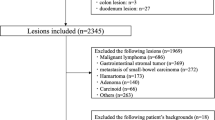Abstract
The performance of colon polypectomy has proven to be one of the most impactful services provided by today’s endoscopist. Advancements in instrumentation and endoscopic techniques have been studied intensely by endoscopists over the past decade in order to expand their extent of resection capabilities to large and complex polyps. Much of the research in the past year has focused on the safety and efficacy of performing endoscopic mucosal resection (EMR), endoscopic submucosal dissection (ESD), and combined laparascopic-endoscopic resections (CLER). Experts have published case-series, multicenter studies, and even nationwide results on the use of these methods for complex polypectomy. Because of the novelty and increased risk of these procedures, recent research has also focused on the prevention, identification and management of complications related to polypectomy, particularly bleeding and perforation. This manuscript will review the recent literature addressing basic and advanced colon polypectomy techniques.

Similar content being viewed by others
References
Papers of particular interest, published recently, have been highlighted as: •Of importance •• Of major importance
Fyock CJ, Draganov PV. Colonoscopic polypectomy and associated techniques. World J Gastroenterol. 2010;16(29):3630–7.
Gallegos-Orozco JF, Gurudu SR. Complex colon polypectomy. Gastroenterol Hepatol (N Y). 2010;6(6):375–82.
Lau PC, Sung JJ. Flat adenoma in colon: two decades of debate. J Dig Dis. 2010;11(4):201–7.
Ahlawat SK, Gupta N, Benjamin SB, et al. Large colorectal polyps: endoscopic management and rate of malignancy: does size matter? J Clin Gastroenterol. 2011;45(4):347–54.
Binmoeller KF, Bohnacker S, Seifert H, et al. Endoscopic snare excision of “giant” colorectal polyps. Gastrointest Endosc. 1996;43:183–8.
Conio M, Repici A, Demarquay J, et al. EMR of large sessile colorectal polyps. Gastrointest Endosc. 2004;60:234–41.
Heldwein W, Dollhop M, Rosch T, et al. The Munich Polypectomy Study (MUPS): prospective analysis of complications and risk factors in 4000 colonic snare polypectomies. Endoscopy. 2005;37:1116–22.
Ferrara F, Luigiano C, Ghersi S, et al. Efficacy, safety and outcomes of 'inject and cut' endoscopic mucosal resection for large sessile and flat colorectal polyps. Digestion. 2010;82(4):213–20. Epub 2010 Jun 24.
Iambrenghi O, Ugenti I, Martines G, et al. Endoscopic management of large colorectal polyps. Int J Colorectal Dis. 2009;24(7):749–53. Epub 2009 Mar 4.
Deprez PH, Bergman JJ, Meisner S, et al. Current practice with endoscopic submucosal dissection in Europe: position statement from a panel of experts. Endoscopy. 2010;42(10):853–8. Epub 2010 Jul 9.
• Heresbach D, Kornhauser R, Seyrig JA, et al.: A national survey of endoscopic mucosal resection for superficial gastrointestinal neoplasia. Endoscopy. 2010 Oct;42(10):806–13. Epub 2010 Sep 6. EMR is effectively performed by non-polypectomy experts with results comparable to published literature and academic centers
Oka S, Tanaka S, Kanao H, et al. Current status in the occurrence of postoperative bleeding, perforation and residual/local recurrence during colonoscopic treatment in Japan. Dig Endosc. 2010;22(4):376–80.
Neuhaus H. Endoscopic mucosal resection and endoscopic submucosal dissection in the West--too many concerns and caveats? Endoscopy. 2010;42(10):859–61. Epub 2010 Sep 30.
Hon SS, Ng SS, Lee JF, et al. In vitro porcine training model for colonic endoscopic submucosal dissection: an inexpensive and safe way to acquire a complex endoscopic technique. Surg Endosc. 2010;24(10):2439–43. Epub 2010 Mar 24.
Hauenschild L, Bader FG, Laubert T, et al. Laparoscopic colorectal resection for benign polyps not suitable for endoscopic polypectomy. Int J Colorectal Dis. 2009;24(7):755–9. Epub 2009 Mar 13.
Wilhelm D, von Delius S, Weber L, et al. Combined laparoscopic-endoscopic resections of colorectal polyps: 10-year experience and follow-up. Surg Endosc. 2009;23(4):688–93. Epub 2009 Jan 24.
Grünhagen DJ, Van Ierland MC, Doomebosch PG, et al.: Laparoscopic-monitored colonoscopic polypectomy: a multimodality method to avoid segmental colon resection. Colorectal Dis. 2010 Nov 19.
• Buddingh KT, Herngreen T, Haringsma J, et al.: Location in the Right Hemi-Colon Is an Independent Risk Factor for Delayed Post-Polypectomy Hemorrhage: A Multi-Center Case-Control Study. Am J Gastroenterol. 2011 Jan 25. The first publication specifically indicating that right-side polyps independently increase the risk for delayed post-polypectomy bleeding. Post-polypectomy prophylaxis with hemoclips merit investigation.
Watabe H, Yamaji Y, Okamoto M, et al. Risk assessment for delayed hemorrhagic complication of colonic polypectomy: polyp-related factors and patient-related factors. Gastrointest Endosc. 2006;64:73–8.
Sawhney MS, Salfiti N, Nelson DB, et al. Risk factors for severe delayed postpolypectomy bleeding. Endoscopy. 2008;40:115–9.
Witt DM, Delate T, McCool KH, et al. Incidence and predictors of bleeding or thrombosis after polypectomy in patients receiving and not receiving anticoagulation therapy. J Thromb Haemost. 2009;7(12):1982–9. Epub 2009 Aug 28.
•• Swan MP, Bourke MJ, Moss A, et al. The target sign: an endoscopic marker for the resection of the muscularis propria and potential perforation during colonic endoscopic mucosal resection. Gastrointest Endosc. 2011;73(1):79–85. First description of an endoscopic predictor of deep resection or perforation. Recognition of the ‘target sign’ can prevent need for surgical management.
•• Panteris V, Haringsma J, Kuipers EJ: Colonoscopy perforation rate, mechanisms and outcome: from diagnostic to therapeutic colonoscopy. Endoscopy. 2009 Nov;41(11):941–51. Epub 2009 Oct 28. Determination that perforation rates from therapeutic colonoscopy have decreased in recent years, compared to previously published data. Advanced polypectomy is relatively safe in community practice.
Disclosure
No potential conflicts of interest relevant to this article were reported.
Author information
Authors and Affiliations
Corresponding author
Rights and permissions
About this article
Cite this article
Kedia, P., Waye, J.D. Routine and Advanced Polypectomy Techniques. Curr Gastroenterol Rep 13, 506–511 (2011). https://doi.org/10.1007/s11894-011-0210-z
Published:
Issue Date:
DOI: https://doi.org/10.1007/s11894-011-0210-z




